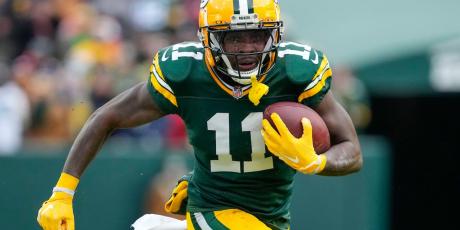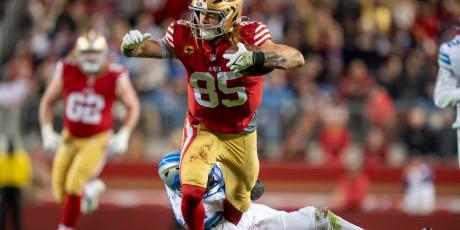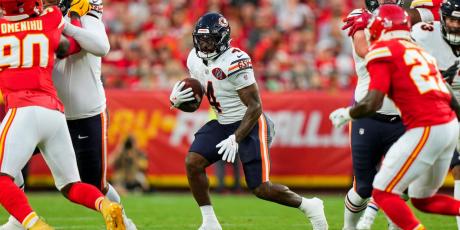DeMarco Murray and Derrick Henry: Fantasy's Next Dominant Tandem?

In a surprising twist, “exotic smash-mouth” was actually a thing in 2016. The Titans have an embarrassment of riches at the running back position with DeMarco Murray and Derrick Henry behind one of the best offensive lines in football. Murray was given feature-back volume in 2016, but faded down the stretch due to nagging injuries.
At 6-foot-3 and 247 pounds, Henry profiles more like a cartoon character than a running back— and he has reportedly made strides this offseason. But does that even matter? Murray has been the unquestioned workhorse in the Titans' offense when healthy, and head coach Mike Mularkey has a history of feeding his lead back while favoring the run.
Is Murray’s upside behind a top-notch offensive line higher than the other high-volume backs in his ADP range? Is the theoretical ceiling of Henry worth his average draft position?
My Rushing Expectation charting, which balances metrics with film evaluation—one of the toughest things to do in fantasy football—can provide some clues as to how to attack the Titans' backfield in fantasy drafts.
Sign up with 4for4 to gain access to every single Rushing Expectation profile of 2017!
Rushing Expectation: DeMarco Murray
Murray displays rare burst to get to the edge, but also very good acceleration to break long plays. He’s an explosive athlete with rare mental processing skills and very good maturity between the tackles.
In charting Murray, I saw a running back with very good athletic ability and a rare ability to press tight creases. He’s a tough runner and demonstrates above-average versatility, which meshes well with his extra gear and big-play ability. Murray displays very good finish and consistently falls forward through contact.
Murray's receiving ability is above average, but his true value as a receiver is his very good ability to gain chunks of yardage after the catch. Interestingly enough, his efficiency in the receiving game was poor. He ended up with a 6th percentile receiving Expectation Score—mainly due to a handful of incomplete passes on which it was difficult to say who was at fault between him and the quarterback.
Murray's largest rushing sample comes running through the middle and left, which is where he has been most successful:
The Titans' overall Expected Success Rate in 2016 on rushing attempts was 48.5 percent, which was fourth-highest in the league and well above the NFL average of 46.3 percent. They were slightly below average at blocking on targets to running backs, posting an Expected Success Rate of 43.4 percent.
Relative to my 60-player sample, Murray finished with a 66th percentile rushing Expectation Score in 2016. That may seem underwhelming, but behind such a strong offensive line his expectation is sky high. In raw Success Rate, Murray finished in the 92nd percentile versus seven or less defenders in the box and the 70th percentile versus eight or more in the box.
Murray posted a 75th percentile average in yards before contact, which probably had more to do with his strong offensive line play than his vision. Subpar vision, however, has been one of the knocks on Murray throughout his career—but that’s not what I saw on film. I found Murray to be very good at finding lanes and picking spots to bounce outside, especially against eight or more in the box, which he faced at a rate in the 93rd percentile.
Overall, charting Murray has provided two noteworthy takeaways:
-
Murray has rare burst and the versatility of a bell-cow back.
-
Murray was inefficient in the passing game.
Murray provided a slightly below average 49th percentile yards after contact average, and their’s a lot of tread on those tires. Does Henry provide standalone value, or are we still year or two away from seeing this guy go off?
Rushing Expectation: Derrick Henry
Henry displays force at the point of attack that not many backs can fathom. His strength is unique. His power is absolutely elite. The collisions he creates are eye-popping, and he seemingly is never on the wrong side of one, no matter which direction he runs.
In charting Henry, I saw more than a boom-or-bust, straight-line runner.
Henry’s vision is borderline elite in the way he uses his blocks—part of the reason he runs defenders over is he is very good at baiting them into situations he knows he can win.
Henry’s speed is above average, but let’s be honest, the pure size and strength of this guy provides him with enough force that he doesn’t need elite speed to be a rare finisher.
Behind the Titans strong run blocking, Henry performed well above expectation rushing the football. Among my 60-player sample, he finished in the 70th percentile in terms of rushing Expectation Score despite his line's high expectation. He’s a guy who definitely stands out in my methodology. He has the ability to make consistent gains that help the offense. He is also far less reliant than the typical running back on big plays or soft defensive fronts to produce.
Rare mental processing and very good football IQ make Henry even more special. He saw eight or more in the box at a frequency in the 98th percentile, but his raw success rate falls in the 90th percentile overall. That’s insane. Oh yeah: when he saw seven or fewer in the box, his efficiency finished in the 98th percentile.
That said, it is somewhat of a red flag that Henry finished in the 42nd percentile in yards before contact. His numbers in that area were poor compared to Murray. Intuitively, this could either be because Henry seeks out contact or because of merely average agility and hip flexibility. I’m not sure if it's a huge issue for Henry given his unique skill set, but it's still a negative indicator and relevant nonetheless. Henry's agility and change-of-direction are average. Ultimately, Henry's unique frame supersedes any fears about him, in my opinion—especially since he will run behind an elite offensive line.
Henry has good hands, but only saw eight targets in the sample I charted. He’s not as versatile as Murray in the passing game, but he can still be effective in the right setting. He performed well above expectation on targets to the outside, showing the ability to adjust to the ball with ease, which I didn’t expect.
Overall, charting Henry has provided three noteworthy takeaways:
-
Henry is a freak physical specimen with elite strength and power.
-
Henry has mental processing ability that is highly underrated.
-
Henry has room for growth in the passing game.
DeMarco Murray: 2017 Fantasy Outlook
Safe to say, I loved what I saw from Henry on film, but DeMarco is clearly the guy in 2017. This is not a 1A/1B situation.
However, there are a few concerns about Murray's fantasy value:
-
Murray led the Titans in red zone targets last season, which should regress a bit with the addition of Eric Decker.
-
Murray was given over 60 percent of the carries last year when both he and Henry were healthy, but Henry’s role increased down the stretch.
That said, Murray’s workload is likely safe. The coaching staff has shown commitment to him even though Henry has been the better back at times.
Ultimately, there’s a lot to like when it comes to Murray and his fantasy value:
-
Murray runs behind one of the best offensive lines in the league.
-
Murray sees feature-back volume on the ground.
-
Murray is used extensively in the passing game and red zone.
-
Murray plays with a reasonably mobile quarterback.
Murray was a league-winner last year at RB15, and is probably still undervalued at RB8. I would prefer Murray to Melvin Gordon, Jordan Howard, or Todd Gurley for sure. Murray's overall volume and usage should remain intact while he runs behind a strong offensive line.
Derrick Henry: 2017 Fantasy Outlook
Looking purely at track record, Mularkey is typically not in favor of a committee approach in his backfield. That said, when Murray was nicked up over the last six games, Henry saw 13 red zone carries. Maybe Mularkey will come around and start using both backs in a similar fashion to how Atlanta used Devonta Freeman and Tevin Coleman last year. If that happens, Henry will have the best standalone value of any backup running back in the league. Either way, he has vastly understated upside.
I love Henry. Most people will tell you that RB37 is too rich of an ADP for a backup—but that cost has gone down in recent months. As I write this, I am realizing how underweight on Henry I am in best-ball. Henry could be a league-winner. While I could easily be a year early on Henry, I'm still going to increase my exposure to him before Week 1.
Note: Use our ADP tool to see the most up-to-date ADP on Murray and Henry, and our rankings (updated daily) and customizable cheat cheets to plan for your 2017 fantasy draft.
Related Articles
- Is One Good Year Enough to Trust Melvin Gordon as a Fantasy Stud?
- Rushing Expectation 2017 List
- Is Terrance West Actually Any Good?
- Jay Ajayi Has One of the Best Floor/Ceiling Combos in Fantasy
- Why Jordan Howard is Being Overvalued in Fantasy Football
- Marshawn Lynch's Handcuff: DeAndre Washington or Jalen Richard?
- Why You Should Avoid the Vikings' Backfield in Fantasy Football
- Spencer Ware's League-Winning Fantasy Upside is Being Ignored
- 7 Running Backs With an Easy Fantasy Strength of Schedule
- Bilal Powell is the Jets Back to Own Because Matt Forte is Trash Now
- Todd Gurley Isn't Worth Your Second-Round Fantasy Pick
- Ty Montgomery Has Massive Fantasy Upside
- Ameer Abdullah is the Lions Running Back to Own in Fantasy
- Does Isaiah Crowell or Duke Johnson Offer More Fantasy Value?
- Rushing Expectation 2017: An Introduction
- The Fantasy Value of Patriots Running Backs Mike Gillislee, James White, Dion Lewis & Rex Burkhead
- Stop Taking Adrian Peterson Over Mark Ingram in Fantasy
- Using Red Zone Expected Value to Find 5 Running Back Touchdown Regression Candidates
- What are the Most Predictable Year-to-Year Stats for Running Backs?
- 6 Reasons Jordan Howard Will Not Be a Fantasy Football Bust
- Leonard Fournette, Samaje Perine & the Other Rookies That Will Make a Fantasy Impact in 2017
- When Should You Draft Your Running Back?
- How Often Do Top-12 PPR Running Backs and Wide Receivers Repeat the Following Season?
- 2017 Initial Rankings: A Closer Look at Bilal Powell, Danny Woodhead and Theo Riddick
- What the Move to Philadelphia Means for LeGarrette Blount
- Danny Woodhead Had RB1 Upside at This Time Last Year - Does He Still?
- How Effective Will Marshawn Lynch Be in 2017?






















